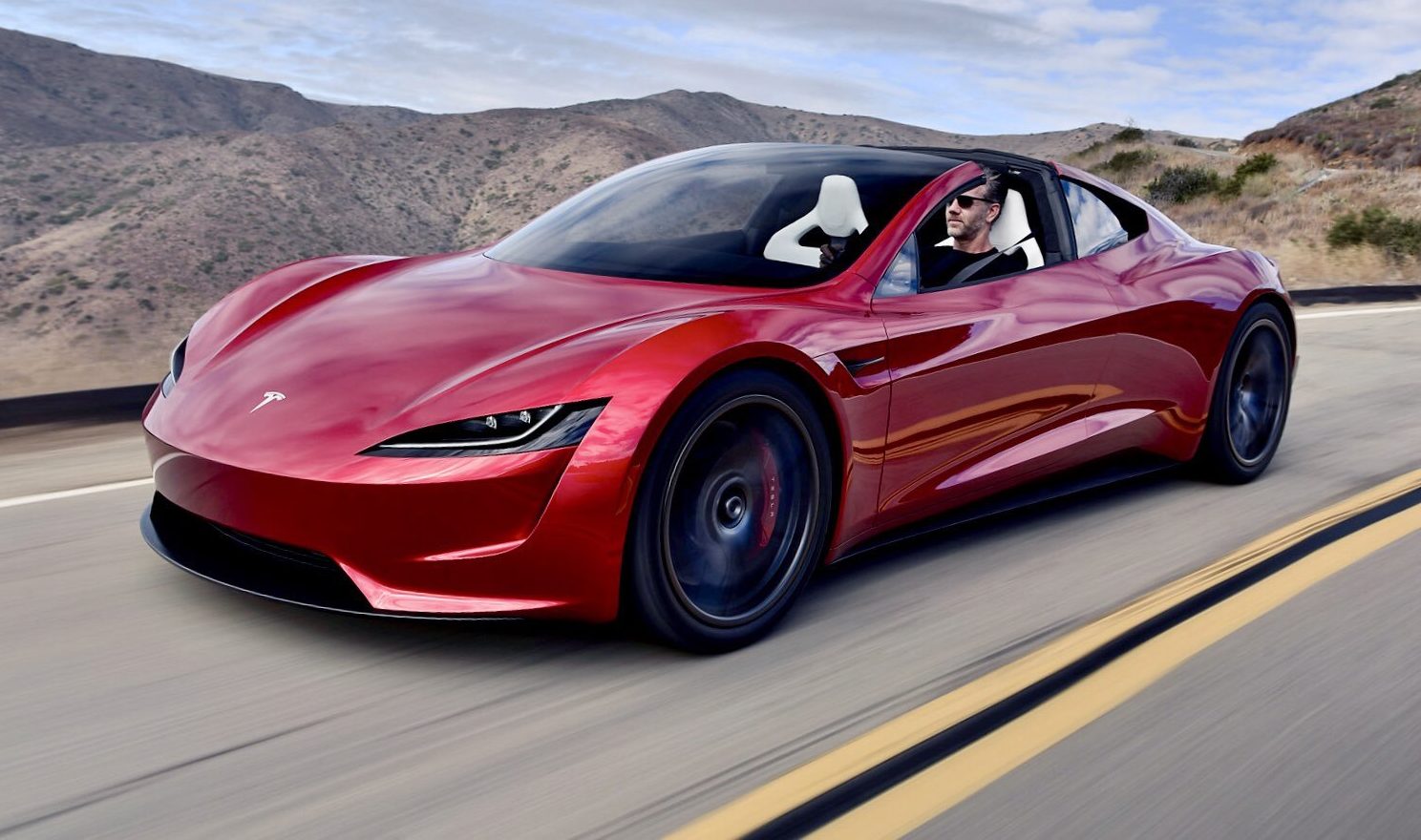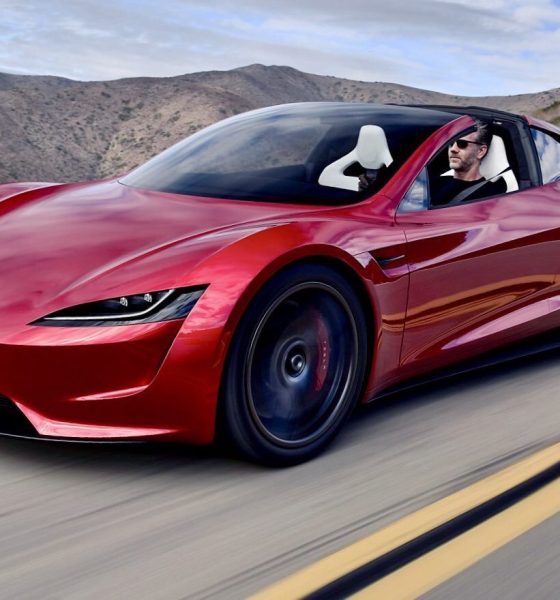

News
Tesla’s next-gen Roadster is ushering in the automotive industry’s ‘Megacar’ era
Elon Musk is a man driven by his limits. The man behind electric car maker Tesla, Musk has led the company from its small Silicon Valley startup days to its current status as a $50 billion automaker with a market cap that rivals that of Ford and GM. With each vehicle that Musk releases, Tesla disrupts an industry, and with the next-generation Roadster, the CEO is aiming to create a true halo car.
Christian von Koenigsegg is a man driven by his passion. The man behind the small, exclusive supercar company Koenigsegg, Christian is known for pushing the limits of the vehicles he releases. Koenigsegg might be far smaller than supercar makers like Ferrari and Lamborghini, but the few cars that it makes shake the automotive world. The Koenigsegg Agera RS, for one, currently holds the title as one of the fastest cars in the world after it reached speeds of 278 mph. The Koenigsegg One:1, named for its equal power-to-weight ratio, also packs 1,341 horsepower, or the equivalent of one megawatt of power. Koenigsegg’s cars are so powerful that some of them actually qualify as a hypercar instead of a supercar.
When Christian von Koenigsegg heard the specs of Tesla’s next-generation Roadster, his entire company’s roadmap for the coming years was shaken. In a recent statement to Top Gear, Koenigsegg admitted that his company was completely thrown off course by the listed specs of the all-electric supercar, even admitting that the experience itself was “frustrating.”
“We kind of had our future mapped out, and then we heard about the new Tesla Roadster and its insane acceleration numbers, and we thought ‘damn that’s put the gauntlet down.’ Sure, it must be really heavy, but that kind of acceleration? That’s frustrating!” he said.
https://www.instagram.com/p/BnDT8v1hKJH/?tagged=teslaroadster
Christian noted that one of the biggest revelations by the arrival of the next-generation Tesla Roadster was that Elon Musk’s quoted specs for the vehicle were actually possible. In order to respond to the arrival of an electric car designed to deliver a “hardcore smackdown” to gas-powered vehicles, Koenigsegg and his engineers came up with a strategy that would allow one of its cars to give the Roadster some good competition.
“We thought, ‘this is not OK.’ We wondered whether it was possible, and yeah, it’s possible. Then we thought, ‘OK how do we deal with it? This is embarrassing.’ In two days we’d thought of a few things. The simplest way of putting it is like this: it’s combining direct drive, with the hybridization we have in a different format with free-valve engine technology, in a peculiar layout,” he said.
The concept that Koenigsegg and his team came up with is pretty much the fossil fuel-powered counterpart of the next-generation Tesla Roadster — one that is beyond a hypercar, perhaps even a “megacar” of sorts. Christian noted that he was partly annoyed at himself, for “needing a kick in the head to start thinking” about improving his vehicles’ acceleration.
“We’re talking 0-250 mph in 14 seconds, or something like this. It’s like, black marks all the way up to 250 mph (400 kph), pushing the combustion engine into the wall to try to make it more power dense than an EV for as long as possible. What we see with our engines, we’ve noticed that we’re just scratching the surface of what we can achieve,” he said.
https://www.instagram.com/p/BnHiOO4FYQv/?taken-by=koenigseggnewportbeach
Elon Musk threw the gauntlet at legacy automakers when he unveiled the next-generation Tesla Roadster last year, and if Christian von Koenigsegg’s reaction to the vehicle is any indication, it appears that the all-electric supercar is doing precisely what it was intended for — it is forcing automakers to see electric cars as a formidable force, and it is driving them to adapt and come up with ways to make their vehicles even better and faster.
Interestingly, such a sentiment has been echoed by Tesla’s test driver for the next-generation Roadster, Emile Bouret, earlier this year. In a segment with YouTube’s VINwiki channel, Bouret, who drove the all-electric car the whole night during its unveiling, encouraged the auto community to support projects and vehicles like the next-generation Roadster, stating that the existence of such vehicles would affect the auto industry in a positive way as a whole.
“I love that I live in a world where all these cars exist. You have Koenigseggs and Paganis and Ferraris and Lamborghinis and McLarens and Porsches and Rimacs and Teslas. So, I know there’s a lot of hate out there, but I just don’t understand it. If you’re a car person, wouldn’t you root for everybody? I’m definitely rooting for them because the world will be a better place if that car does get built and it gets on the road because other people are gonna build cars to beat it — and we’re gonna win,” he said.
Considering that Koenigsegg appears to have come up with a solution to match the next-gen Roadster, it seems that Buoret’s words are coming true. As the Tesla Roadster and Koenigsegg’s upcoming vehicle are released to the market, the era of megacars could very well begin.

News
Tesla starts showing how FSD will change lives in Europe
Local officials tested the system on narrow country roads and were impressed by FSD’s smooth, human-like driving, with some calling the service a game-changer for everyday life in areas that are far from urban centers.

Tesla has launched Europe’s first public shuttle service using Full Self-Driving (Supervised) in the rural Eifelkreis Bitburg-Prüm region of Germany, demonstrating how the technology can restore independence and mobility for people who struggle with limited transport options.
Local officials tested the system on narrow country roads and were impressed by FSD’s smooth, human-like driving, with some calling the service a game-changer for everyday life in areas that are far from urban centers.
Officials see real impact on rural residents
Arzfeld Mayor Johannes Kuhl and District Administrator Andreas Kruppert personally tested the Tesla shuttle service. This allowed them to see just how well FSD navigated winding lanes and rural roads confidently. Kruppert said, “Autonomous driving sounds like science fiction to many, but we simply see here that it works totally well in rural regions too.” Kuhl, for his part, also noted that FSD “feels like a very experienced driver.”
The pilot complements the area’s “Citizen Bus” program, which provides on-demand rides for elderly residents who can no longer drive themselves. Tesla Europe shared a video of a demonstration of the service, highlighting how FSD gives people their freedom back, even in places where public transport is not as prevalent.
What the Ministry for Economic Affairs and Transport says
Rhineland-Palatinate’s Minister Daniela Schmitt supported the project, praising the collaboration that made this “first of its kind in Europe” possible. As per the ministry, the rural rollout for the service shows FSD’s potential beyond major cities, and it delivers tangible benefits like grocery runs, doctor visits, and social connections for isolated residents.
“Reliable and flexible mobility is especially vital in rural areas. With the launch of a shuttle service using self-driving vehicles (FSD supervised) by Tesla in the Eifelkreis Bitburg-Prüm, an innovative pilot project is now getting underway that complements local community bus services. It is the first project of its kind in Europe.
“The result is a real gain for rural mobility: greater accessibility, more flexibility and tangible benefits for everyday life. A strong signal for innovation, cooperation and future-oriented mobility beyond urban centers,” the ministry wrote in a LinkedIn post.
News
Tesla China quietly posts Robotaxi-related job listing
Tesla China is currently seeking a Low Voltage Electrical Engineer to work on circuit board design for the company’s autonomous vehicles.

Tesla has posted a new job listing in Shanghai explicitly tied to its Robotaxi program, fueling speculation that the company is preparing to launch its dedicated autonomous ride-hailing service in China.
As noted in the listing, Tesla China is currently seeking a Low Voltage Electrical Engineer to work on circuit board design for the company’s autonomous vehicles.
Robotaxi-specific role
The listing, which was shared on social media platform X by industry watcher @tslaming, suggested that Tesla China is looking to fill the role urgently. The job listing itself specifically mentions that the person hired for the role will be working on the Low Voltage Hardware team, which would design the circuit boards that would serve as the nervous system of the Robotaxi.
Key tasks for the role, as indicated in the job listing, include collaboration with PCB layout, firmware, mechanical, program management, and validation teams, among other responsibilities. The role is based in Shanghai.
China Robotaxi launch
China represents a massive potential market for robotaxis, with its dense urban centers and supportive policies in select cities. Tesla has limited permission to roll out FSD in the country, though despite this, its vehicles have been hailed as among the best in the market when it comes to autonomous features. So far, at least, it appears that China supports Tesla’s FSD and Robotaxi rollout.
This was hinted at in November, when Tesla brought the Cybercab to the 8th China International Import Expo (CIIE) in Shanghai, marking the first time that the autonomous two-seater was brought to the Asia-Pacific region. The vehicle, despite not having a release date in China, received a significant amount of interest among the event’s attendees.
Elon Musk
Elon Musk and Tesla AI Director share insights after empty driver seat Robotaxi rides
The executives’ unoccupied tests hint at the rapid progress of Tesla’s unsupervised Robotaxi efforts.

Tesla CEO Elon Musk and AI Director Ashok Elluswamy celebrated Christmas Eve by sharing personal experiences with Robotaxi vehicles that had no safety monitor or occupant in the driver’s seat. Musk described the system’s “perfect driving” around Austin, while Elluswamy posted video from the back seat, calling it “an amazing experience.”
The executives’ unoccupied tests hint at the rapid progress of Tesla’s unsupervised Robotaxi efforts.
Elon and Ashok’s firsthand Robotaxi insights
Prior to Musk and the Tesla AI Director’s posts, sightings of unmanned Teslas navigating public roads were widely shared on social media. One such vehicle was spotted in Austin, Texas, which Elon Musk acknowleged by stating that “Testing is underway with no occupants in the car.”
Based on his Christmas Eve post, Musk seemed to have tested an unmanned Tesla himself. “A Tesla with no safety monitor in the car and me sitting in the passenger seat took me all around Austin on Sunday with perfect driving,” Musk wrote in his post.
Elluswamy responded with a 2-minute video showing himself in the rear of an unmanned Tesla. The video featured the vehicle’s empty front seats, as well as its smooth handling through real-world traffic. He captioned his video with the words, “It’s an amazing experience!”
Towards Unsupervised operations
During an xAI Hackathon earlier this month, Elon Musk mentioned that Tesla owed be removing Safety Monitors from its Robotaxis in Austin in just three weeks. “Unsupervised is pretty much solved at this point. So there will be Tesla Robotaxis operating in Austin with no one in them. Not even anyone in the passenger seat in about three weeks,” he said. Musk echoed similar estimates at the 2025 Annual Shareholder Meeting and the Q3 2025 earnings call.
Considering the insights that were posted Musk and Elluswamy, it does appear that Tesla is working hard towards operating its Robotaxis with no safety monitors. This is quite impressive considering that the service was launched just earlier this year.








